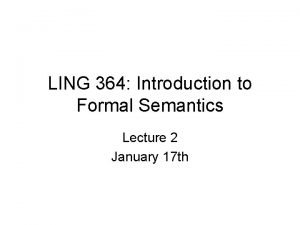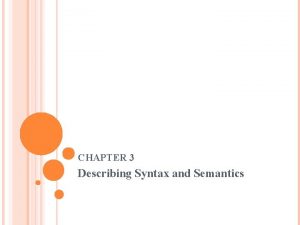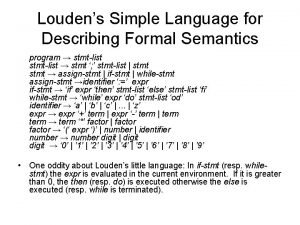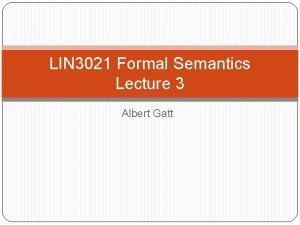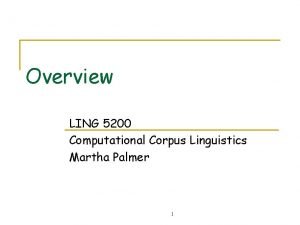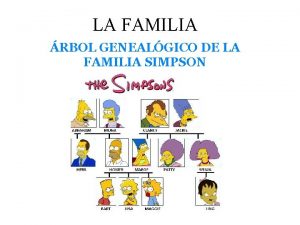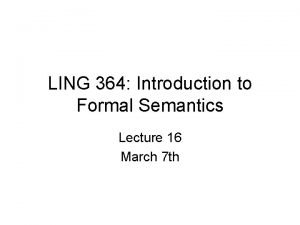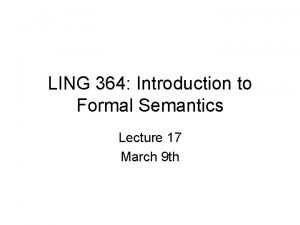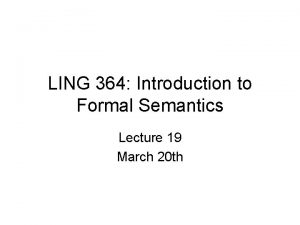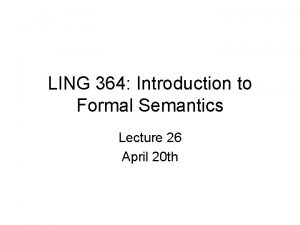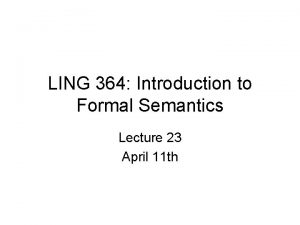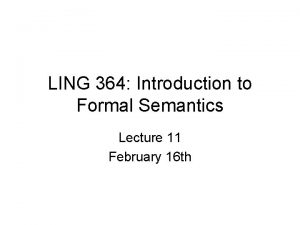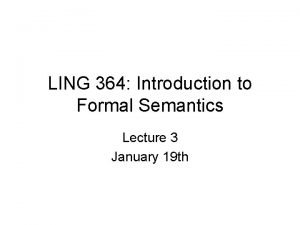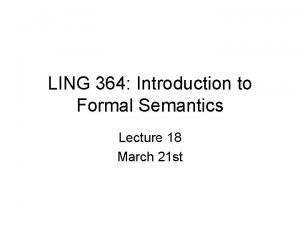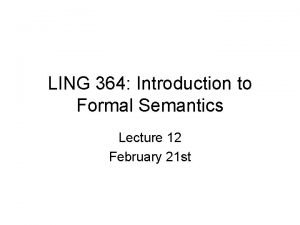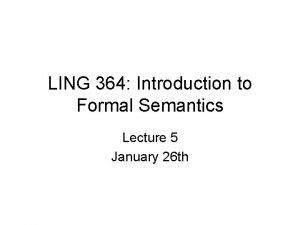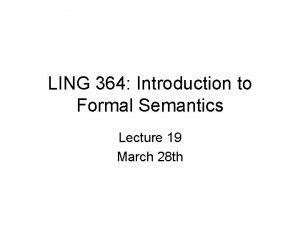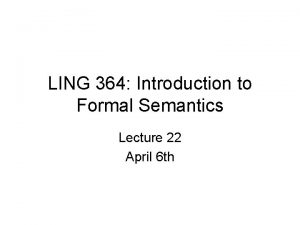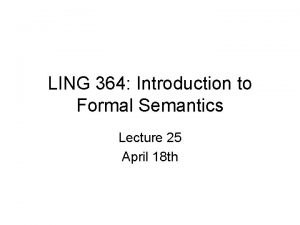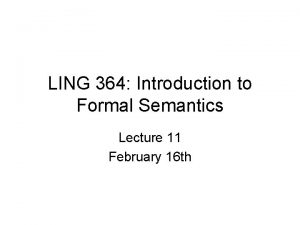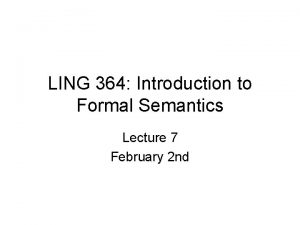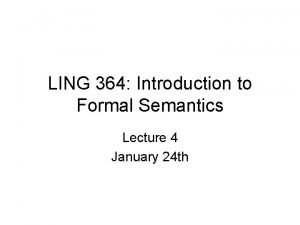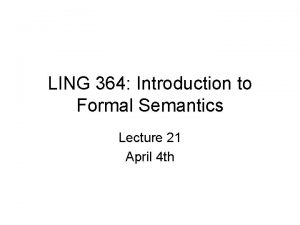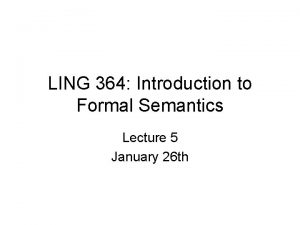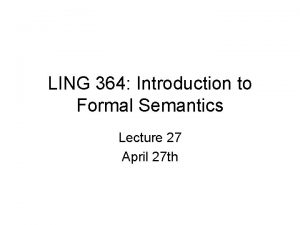LING 364 Introduction to Formal Semantics Lecture 21






![Conversion to Prolog form • • Show – ∀X. [baby(X) -> walks(X)] is equivalent Conversion to Prolog form • • Show – ∀X. [baby(X) -> walks(X)] is equivalent](https://slidetodoc.com/presentation_image/035e8465e48eb4ac923480a7833c97d5/image-7.jpg)



![Last Time • • Defining every_baby(P)? (Montague-style) λP. [∀X. baby(X) -> P(X)] • • Last Time • • Defining every_baby(P)? (Montague-style) λP. [∀X. baby(X) -> P(X)] • •](https://slidetodoc.com/presentation_image/035e8465e48eb4ac923480a7833c97d5/image-11.jpg)




![Quantifiers • Example: [S [NP [Q every][N man]][VP [V likes][NP John]]] – – – Quantifiers • Example: [S [NP [Q every][N man]][VP [V likes][NP John]]] – – –](https://slidetodoc.com/presentation_image/035e8465e48eb4ac923480a7833c97d5/image-16.jpg)
![Quantifiers • Example: [S [NP [Q every][N man]][VP [V likes][NP John]]] – – – Quantifiers • Example: [S [NP [Q every][N man]][VP [V likes][NP John]]] – – –](https://slidetodoc.com/presentation_image/035e8465e48eb4ac923480a7833c97d5/image-17.jpg)
![Quantifiers • Example: [S [NP [Q every][N man]][VP [V likes][NP John]]] – – – Quantifiers • Example: [S [NP [Q every][N man]][VP [V likes][NP John]]] – – –](https://slidetodoc.com/presentation_image/035e8465e48eb4ac923480a7833c97d5/image-18.jpg)
![Quantifiers • Example: [S [NP [Q every][N man]][VP [V likes][NP John]]] – – – Quantifiers • Example: [S [NP [Q every][N man]][VP [V likes][NP John]]] – – –](https://slidetodoc.com/presentation_image/035e8465e48eb4ac923480a7833c97d5/image-19.jpg)



- Slides: 22

LING 364: Introduction to Formal Semantics Lecture 21 April 4 th

Administrivia • Homework 3 – graded and returned – homework 4 should be coming back this week as well

Administrivia • this Thursday – computer lab class – fun with quantifiers. . . homework 5 – meet in SS 224

Today’s Topic • Continue with – Reading Chapter 6: Quantifiers – Quiz 5 (end of class: postponed)

Last Time • Quantified NPs: (6) – “something to do with indicating the quantity of something” – every child, nobody cried – two dogs, several animals – most people jumped • • • think of quantifiers as “properties-of-properties” every_baby(P) is a proposition P: property every_baby(P) true for P=cried every_baby(P) false for P=jumped and P=swam every baby exactly one baby ✓ most babies ✓ ✓ ✓ Generalized quantifiers: sets of sets property = set

Last Time • • • Defining every_baby(P)? (Montague-style) every_baby(P) is shorthand for – λP. [∀X. [baby(X) -> P(X)]] – ∀: for all (universal quantifier: logic symbol) • Example: – every baby walks – [NP every baby] [VP walks] • • λP. [∀X. [baby(X) -> P(X)]] (walks) ∀X. [baby(X) ->walks(X)] • Prolog-style: • ? - + (baby(X), + walks(X)). “it’s not true that there is a baby (X) who doesn’t walk”
![Conversion to Prolog form Show X babyX walksX is equivalent Conversion to Prolog form • • Show – ∀X. [baby(X) -> walks(X)] is equivalent](https://slidetodoc.com/presentation_image/035e8465e48eb4ac923480a7833c97d5/image-7.jpg)
Conversion to Prolog form • • Show – ∀X. [baby(X) -> walks(X)] is equivalent to (can be translated into): – ? - + (baby(X), + walks(X)). We’re going to use the idea that ∀X P(X) is the same as ¬∃X ¬P(X) let’s call this the “no exception” idea ∃= “there exists” (quantifier) (implicitly: all Prolog variables are existentially quantified variables) need to translate this a Prolog variable like X in this query has the meaning: “give me some value of X such that baby(X) is true” i. e. “give me some X” i. e. ∃X baby(X)

Aside: Truth Tables logic of implication P v Q Pv. Q=F only when • • • P -> Q = (truth value) T T T F F T T T • i. e. if P is true, Q must be true in order for P->Q to be true if P is false, doesn’t matter what Q is, P->Q is true • • • conventionally written as: P -> Q T T T F T F F both P and Q are F F T T F F F ¬P v Q T T F TF T T FT F F TF T T ¬Pv. Q=F only when P=T and Q=F Hence, P->Q is equivalent to ¬Pv. Q P->Q=F only when P=T and Q=F

Aside: Truth Tables • De Morgan’s Rule • ¬(P∨Q) = ¬P∧¬Q ¬P ∧ ¬Q FT F FT TF FT P v Q ¬(Pv. Q) T T T F F F F T T T F F ¬(Pv. Q)=T only when both P and Q are F Hence, ¬(Pv. Q) is equivalent to ¬P∧¬Q=T only when both P and Q are F

Conversion into Prolog Note: + (baby(X), +walks(X)) is Prolog for ∀X (baby(X) -> walks(X)) Steps: – ∀X (baby(X) -> walks(X)) – ∀X (¬baby(X) v walks(X)) • (since P->Q = ¬Pv. Q, see truth tables from two slides ago) – ¬∃X ¬ (¬baby(X) v walks(X)) • (since ∀X P(X) = ¬∃X ¬P(X), no exception idea from 3 slides ago) – ¬∃X (baby(X) ∧¬walks(X)) • (by De Morgan’s rule, see truth table from last slide) – ¬(baby(X) ∧¬walks(X)) • (can drop ∃X since all Prolog variables are basically existentially quantified variables) – + (baby(X) ∧ +walks(X)) • (+ = Prolog negation symbol) – + (baby(X), +walks(X)) • (, = Prolog conjunction symbol)
![Last Time Defining everybabyP Montaguestyle λP X babyX PX Last Time • • Defining every_baby(P)? (Montague-style) λP. [∀X. baby(X) -> P(X)] • •](https://slidetodoc.com/presentation_image/035e8465e48eb4ac923480a7833c97d5/image-11.jpg)
Last Time • • Defining every_baby(P)? (Montague-style) λP. [∀X. baby(X) -> P(X)] • • • (Barwise & Cooper-style) think directly in terms of sets leads to another way of expressing the Prolog query • • Example: every baby walks {X: baby(X)} set of all X such that baby(X) is true {X: walks(X)} set of all X such that walks(X) is true • • • Subset relation (⊆) {X: baby(X)} ⊆{X: walks(X)} the “baby” set must be a subset of the “walks” set • Imagine a possible world: – – – – baby(a). baby(b). baby(c). walks(a). walks(b). walks(c). walks(d). – {a, b, c} ⊆ {a, b, c, d} – baby ⊆ walks

Subset and Prolog • How to express this as a Prolog query? • • • Findall/3 queries: ? - findall(X, baby(X), L 1). L 1 is the set of all babies in the database ? - findall(X, walks(X), L 2). L 2 is the set of all individuals who walk Also need a Prolog definition of the subset relation. For example: subset([], _). “empty set is a subset of anything” subset([X|L 1], L 2) : - member(X, L 2), subset(L 1, L 2). member(X, [X|_]). member(X, [_|L]) : - member(X, L). Prolog Head-Tail List Notation: [a, b, c] a is the head of the list (the first element) [b, c] is the tail of the list (all but the first element) we can write a list as follows: [head | tail] [a | [b, c] ] programmatically: [ X | L 1] will match [a, b, c] when X = a, L 1 = [b, c]

Generalized Quantifiers • • • Example: every baby walks {X: baby(X)} ⊆{X: walks(X)} the “baby” set must be a subset of the “walks” set Assume the following definitions are part of the database: subset([], _). subset([X|L 1], L 2) : - member(X, L 2), subset(L 1, L 2). member(X, [X|_ ]). member(X, [ _|L]) : - member(X, L). Prolog Query: ? - findall(X, baby(X), L 1), findall(X, walks(X), L 2), subset(L 1, L 2). • • • True for world: – baby(a). – walks(a). • baby(b). walks(b). walks(c). L 1 = [a, b] L 2 = [a, b, c] ? - subset(L 1, L 2) is true False for world: – baby(a). – walks(a). baby(b). walks(b). baby(d). walks(c). L 1 = [a, b, d] L 2 = [a, b, c] ? - subset(L 1, L 2) is false

Generalized Quantifiers • • • Example: every baby walks (Montague-style) (Barwise & Cooper-style) • • • how do we define every_baby(P)? (Montague-style) λP. [∀X (baby(X) -> P(X))] (Barwise & Cooper-style) {X: baby(X)} ⊆ {X: P(X)} • • • how do we define every? (Montague-style) (Barwise & Cooper-style) ∀X (baby(X) -> walks(X)) {X: baby(X)} ⊆ {X: walks(X)} λP 1. [λP 2. [∀X (P 1(X) -> P 2(X))]] {X: P 1(X)} ⊆ {X: P 2(X)}

Quantifiers • • how do we define the expression every? (Montague-style) λP 1. [λP 2. [∀X (P 1(X) -> P 2(X))]] • • Let’s look at computation in the lambda calculus. . . Example: every man likes John – – – • Word every man likes John Expression λP 1. [λP 2. [∀X (P 1(X) -> P 2(X))]] man λY. [λX. [ X likes Y]] John Syntax: [S [NP [Q every][N man]][VP [V likes][NP John]]]
![Quantifiers Example S NP Q everyN manVP V likesNP John Quantifiers • Example: [S [NP [Q every][N man]][VP [V likes][NP John]]] – – –](https://slidetodoc.com/presentation_image/035e8465e48eb4ac923480a7833c97d5/image-16.jpg)
Quantifiers • Example: [S [NP [Q every][N man]][VP [V likes][NP John]]] – – – • Word every man likes John Expression λP 1. [λP 2. [∀X (P 1(X) -> P 2(X))]] man λY. [λX. [ X likes Y]] John Steps: [Q every][N man]] λP 1. [λP 2. [∀X (P 1(X) -> P 2(X))]](man) [Q every][N man]] λP 2. [∀X (man(X) -> P 2(X))] [VP [V likes][NP John]] λY. [λX. [ X likes Y]](John) [VP [V likes][NP John]] λX. [ X likes John] [S [NP [Q every][N man]][VP [V likes][NP John]]] λP 2. [∀X (man(X) -> P 2(X))](λX. [ X likes John]) ∀X (man(X) -> λX. [ X likes John](X))
![Quantifiers Example S NP Q everyN manVP V likesNP John Quantifiers • Example: [S [NP [Q every][N man]][VP [V likes][NP John]]] – – –](https://slidetodoc.com/presentation_image/035e8465e48eb4ac923480a7833c97d5/image-17.jpg)
Quantifiers • Example: [S [NP [Q every][N man]][VP [V likes][NP John]]] – – – • Word every man likes John Steps (Prolog-style): [Q every][N man] [NP [Q every][N man]]] Expression + (P 1, + P 2). man(X). likes(X, Y). john extra parentheses needed here I’ve cheated a bit here. . . this X is the same X as the X in man(X). . . in a program I would have to also saturate both to the same variable ? - Q = (+ (P 1, +P 2)), N= man(X), arg(1, E, C), saturate 1(C, N). NP = + (man(X), + P 2). (pass up saturated Q as the value for the NP) [V likes][NP John] ? - V = likes(X, Y), NP=john, saturate 2(V, NP). [VP [V likes][NP John]] VP = likes(X, john). (pass up saturated V as the value for the VP) [NP [Q every][N man]][VP [V likes][NP John]] ? - NP = (+ (man(X), + P 2)), VP = likes(X, john), arg(1, NP, C), arg(2, C, Neg), arg(1, Neg, VP). ��[S [NP [Q every][N man]][VP [V likes][NP John]]] S = + (man(X), +likes(X, john)) (pass up saturated NP as the value for S)
![Quantifiers Example S NP Q everyN manVP V likesNP John Quantifiers • Example: [S [NP [Q every][N man]][VP [V likes][NP John]]] – – –](https://slidetodoc.com/presentation_image/035e8465e48eb4ac923480a7833c97d5/image-18.jpg)
Quantifiers • Example: [S [NP [Q every][N man]][VP [V likes][NP John]]] – – – • Word every man likes John Set theory version Expression findall(U, P 1, L 1), findall(V, P 2, L 2), subset(L 1, L 2). man(M). likes(A, B). john Steps: [Q every][N man]] Q= (findall(U, P 1, L 1), findall(V, P 2, L 2), subset(L 1, L 2)), N = man(M), arg(1, Q, FA 1), arg(2, FA 1, N), saturate 1(FA 1, X), saturate 1(N, X). [NP[Q every][N man]]] NP = findall(X, man(X), L 1), findall(V, P 2, L 2), subset(L 1, L 2) (pass up saturated Q as the value for the NP) [V likes][NP John] V=likes(A, B), NP=john, saturate 2(V, NP). [VP [V likes][NP John]] VP = likes(A, john) (pass up saturated V as the value for the VP) [NP [Q every][N man]][VP [V likes][NP John]] NP = (findall(X, man(X), L 1), findall(V, P 2, L 2), subset(L 1, L 2)), VP = likes(A, john), arg(2, NP, C 2), arg(1, C 2, FA 2), arg(2, FA 2, VP), saturate 1(FA 2, Y), saturate 1(VP, Z).
![Quantifiers Example S NP Q everyN manVP V likesNP John Quantifiers • Example: [S [NP [Q every][N man]][VP [V likes][NP John]]] – – –](https://slidetodoc.com/presentation_image/035e8465e48eb4ac923480a7833c97d5/image-19.jpg)
Quantifiers • Example: [S [NP [Q every][N man]][VP [V likes][NP John]]] – – – • Word every man likes John Expression findall(U, P 1, L 1), findall(V, P 2, L 2), subset(L 1, L 2). man(M). likes(A, B). john Steps: [NP [Q every][N man]][VP [V likes][NP John]] ? - NP = (findall(X, man(X), L 1), findall(V, P 2, L 2), subset(L 1, L 2)), VP = likes(A, john), arg(2, NP, C 2), arg(1, C 2, FA 2), arg(2, FA 2, VP), saturate 1(FA 2, Y), saturate 1(VP, Z). [S [NP [Q every][N man]][VP [V likes][NP John]]] S = findall(X, man(X), L 1), findall(Y, likes(Y, john), L 2), subset(L 1, L 2) (pass up saturated NP as the value for S)

Names as Generalized Quantifiers • • • In earlier lectures, Example we mentioned that every baby and John likes ice cream names directly refer [NP[NP every baby] and [NP John]] likes ice cream Here is another idea every baby likes ice cream {X: baby(X)} ⊆ {Y: likes(Y, ice_cream)} Conjunction – X and Y – both X and Y have to be of the same type – in particular, semantically. . . – we want them to have the same semantic type • what is the semantic type of every baby? John likes ice cream ? ? ? ⊆ {Y: likes(Y, ice_cream)} John ∈ {Y: likes(Y, ice_cream)} want everything to be a set (to be consistent) i. e. want to state something like ({X: baby(X)} ∪{X: john(X)}) ⊆ {Y: likes(Y, ice_cream)} note: set union (∪) is the translation of “and”

Negative Polarity Items • Negative Polarity Items (NPIs) • Examples: – every, any • Constrained distribution: – have to be licensed in some way – grammatical in a “negated environment” or “question” • Examples: – (13 a) Shelby won’t ever bite you – (13 b) Nobody has any money – (14 a) *Shelby will ever bite you – (14 b) *Noah has any money – *= ungrammatical – (15 a) Does Shelby ever bite? – (15 b) Does Noah have any money?

Negative Polarity Items • Inside an if-clause: – (16 a) If Shelby ever bites you, I’ll put him up for adoption – (16 b) If Noah has any money, he can buy some candy • Inside an every-NP: – (17 a) Every dog which has ever bitten a cat feels the admiration of other dogs – (17 b) Every child who has any money is likely to waste it on candy • Not inside a some-NP: – (17 a) Some dog which has ever bitten a cat feels the admiration of other dogs – (17 b) Some child who has any money is likely to waste it on candy Not to be confused with free choice (FC) any (meaning: ∀): any man can do that
 1618 lz
1618 lz Round 703 to the nearest hundred
Round 703 to the nearest hundred Bleach 364
Bleach 364 Tm 11-6665-364-12
Tm 11-6665-364-12 Compare procedural semantics and declarative semantics.
Compare procedural semantics and declarative semantics. 01:640:244 lecture notes - lecture 15: plat, idah, farad
01:640:244 lecture notes - lecture 15: plat, idah, farad Invitation to formal semantics
Invitation to formal semantics Describing syntax
Describing syntax What is formal semantics
What is formal semantics Formal semantics
Formal semantics Langue and parole
Langue and parole Jin ling cigarettes
Jin ling cigarettes Mail müstəvi
Mail müstəvi Ling
Ling Erin ling
Erin ling Ling oa
Ling oa Mei-ling from singapore was preparing
Mei-ling from singapore was preparing Como se llama la hija pequeña de los simpson
Como se llama la hija pequeña de los simpson Dr ng li ling
Dr ng li ling Nien-ling wacker
Nien-ling wacker 施玲玲
施玲玲 Ling simpson
Ling simpson Ling adder
Ling adder






